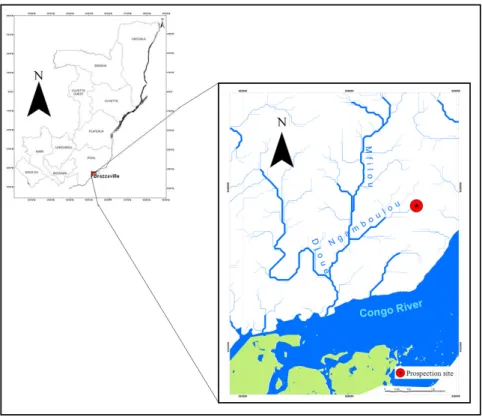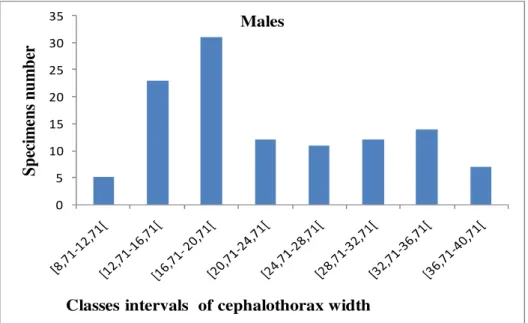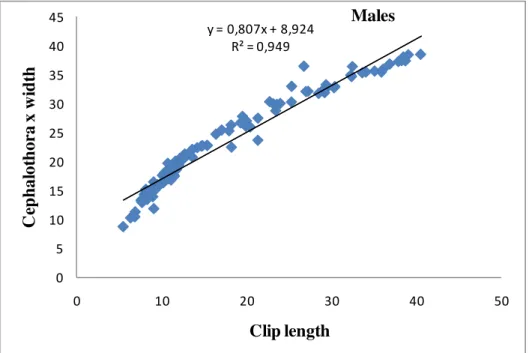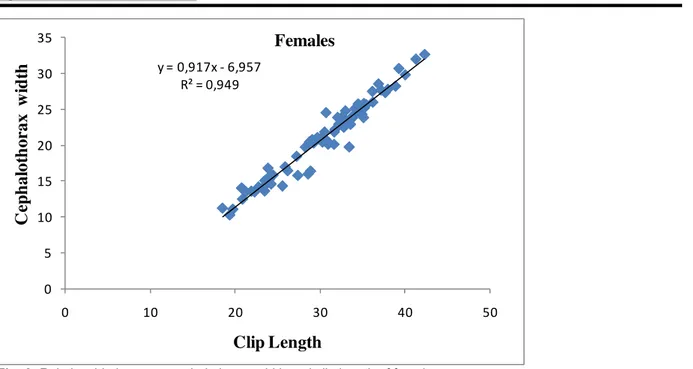Characterization of a Freshwater Crab Sudanonautes
aubryi (Potamonautidae, Brachyura Bott, 1955) of
Ngamboulou River in Brazzaville
Mady-Goma Dirat I.*1, Kouhoueno–Balembonsoni A. G.1 and Vouidibio J.21Research Laboratory of Animal Biology and Ecology, Superior Normal School, University Marien Ngouabi PoB 69
Brazzaville Congo
2Faculty of Sciences and Techniques, University Marien Ngouabi - PoB 69 Congo Brazzaville *Correspondent author: isadir2007@yahoo.fr
Original submitted in on 21st November 2013 Published online at www.m.elewa.org on 31st January 2014.
ABSTRACT
Objective: Crustaceans, like all Congolese benthic macro invertebrates inland waters are poorly known. Bioindicators and intermediate hosts of trematodes, they are also an excellent food source. A preliminary characterization of a common species of freshwater crabs Sudanonautes aubryi (Bott, 1955) was conducted near the Ngamboulou River (tributary of Mfilou River) through the botanic test garden of University Marien Ngouabi from April 2005 to August 2008. This morphometric study was undertaken to describe this species. Methodology and results: The soil was handset at a depth of 15cm, crabs collected by hand, were cleaned in 10l and preserved in alcohol 70°. 186 specimens have been identified and measured, the results show that the sex ratio is equal to 1.62, and the average weight is 6.3g. The average weight of females (8.13g) is higher than that of males (5.03g). The average width of the carapace is 25.73 mm; the carapace of the female is larger (30.18mm) than males (22.99mm). The average length of the clip is 18.66mm. It also appears that females were greater (22.68mm) than males (17.42mm) clip. Ovigerous females were observed between July and September.
Conclusion and application of results: These results will provide a database for management of macro invertebrates’ conservation of Brazzaville Department and of the right bank Congo Basin.
Keywords: Congo Brazzaville, Ngamboulou River, Brachyura, Sudanonautes aubryi, characterization INTRODUCTION
Freshwater crabs are a strangely neglected component of the world’s inland aquatic ecosystems. Despite their wide distribution throughout the tropical and warm temperate zones of the world, and their great diversity (Dobson, 2004), their role in the ecology of freshwaters is very poorly understood. Inland water ecosystems are of great importance for humanity; this importance is often detrimental to biodiversity. Apart from fish, other groups of animals subject to exploitation in inland waters are much less
important in the world, however may be of great interest. Among these animals groups, can be cited freshwater macro invertebrates, particularly crabs, crawfishes and shrimps that are food sources. Crustaceans, like all Congolese freshwater benthic macro invertebrates are poorly known. Furthermore, crabs are recognized as intermediate hosts of trematodosis, specifically paragonimiasis, which is quite common in tropical pulmonary trematodosis (Duong, 2005). This disease has been reported in
Journal of Applied Biosciences 73:6012– 6019
several African countries in the equatorial belt, such as Liberia, Côte d' Ivoire, Burkina Faso, Nigeria, Cameroon and Gabon (WHO, 1995). Crabs, like all benthic macro invertebrates are very sensitive to environmental changes, bio indicators of water quality, they are also an excellent food source. They are highly sensitive to pollution and govern the disturbance in the physic-chemical parameters that in turn induce changes in immune system of crustaceans, by stressing them and resulting in a reduction of immune vigour. Among 4500 crabs species listed in the world, at least one species of freshwater crab tends to disappear of its habitat each year (ref). This loss will undoubtedly have an impact on the entire food chain. Several causes of extinction crabs are known: the pollution by chemicals,
overfishing and illegal fishing industry development and urbanization that disturb their habitats (Vanier, 2005). In Congo Brazzaville, the crabs are less studied; however, Schneider (1992) identified the marine crabs of the Gulf of Guinea, which have a commercial importance. Recently, Cumberlidge and Reed (2004) described the freshwater crab genus Erimetopus of Congo basin. Sudanonautes aubryi, like all others edible crabs are also poorly understood. This preliminary study was undertaken to collect and realize a biometric characterization of this common freshwater crab of the right bank of Congo Basin. Results obtained could be compared with those of others African regions and will give information, which will be used by conservation managers
MATERIAL and METHODS
Presentation of the study area: The crabs were collected in Ngamboulou River, a tributary of the Mfilou River located in south-west of Brazzaville. This river is
between 4.27851 - 04.28832 Southern latitude and between 15.23189 - 15.25099 Eastern longitude (Fig. 1).
Fig. 1: Map of the study area
Sampling methods: The crabs were caught after hoeing space previously weeded in the muddy sandy soil near Ngamboulou River through the test garden of University Marien Ngouabi between April 2007 and August 2008.
The soil was handset up to about 15 cm deep. The crabs were collected by hand, cleaned and preserved in alcohol 70 °.
Morphometric analysis: Each specimen was observed and identified using the identification key established by Monod (1980). Each specimen was weighed using an electronic balance (Oaus), measured using an electronic calliper brand Amig. The cephalothoraxes length was measured using a tape measure. The crabs were divided
into size classes according to Sturge rule (Schereck & Moyle, 1990). Student’s test was used to determine the differences observed between measurements (cephalothorax width and clip length) of males and females.
RESULTS
Sex ratio: Among 186 specimens collected (Fig. 2A, B, C), there are 115 males (or 61.83 %) and 71 females (or 38.17%). The global sex ratio is equal to 1.62 (Table 1), the young crabs had more males (83) than females, the sex ratio is 3.3. In contrary, the sex ratio of adult crabs is
inverted, equal to 0.68, the females are more numerous (47) than males (32). The majority of male were caught to a depth of 15 cm. However, many adult females were captured to a depth of 40cm.
Table 1: Sex Ratio of young and adults following the sex
Total Adult crabs Young crabs
Males 115 32 83
Females 71 47 24
Total 186 79 107
Sex Ratio 1.62 0.68 3.3
Measurements of all crabs: Overall, the weight is between 0.19 and 19.95 g, width of the cephalothorax
width that ranges from 8.71 to 42.35 mm and the clip length varies between 5.47 and 40.55 cm (Table 2). Table 2: Morphometry of all crabs (N=186)
Characters Minimum (mm) Maximum (mm) Means±SD
Weight 0.19 19.95 6.33± 4.87 Cephalothorax length 7.12 30.12 18.94±5.49 Cephalothorax width 8.71 42.35 25.73±8.11 Abdomen length 6 34 17.51±6.82 Telson height 1.04 8.31 4.50±1.66 Clip Length 5.47 40.55 18.66±8.57 Clip Height 1.71 14.13 6.94±3.15 SD= Standard deviation
Measurements of male crabs: The males have a weight between 0.19 and 17.78 g, width of the cephalothorax
between 8.71 and 38.52 mm, and a length of the clip from 5.47 to 40.55 mm (Table 3).
Fig.2.C: The ventral view of the female crab S. aubryi
Fig. 2: A: The dorsal view of crab S. aubryi
Fig.2.B: The ventral view of the male crab S. aubryi
Table 3: Morphometry of male crabs (N=115)
Characters Minimum (mm) Maximum (mm) Means±SD
Weight 0.19 17.78 5.03±4.73 Cephalothorax length 7.12 27.13 16.92±5.32 Cephalothorax width 8.71 38.52 22.99±8.13 Abdomen length 6 23 14.03±4.62 Telson height 1.04 5.99 3.67±1.15 Clip Length 5.47 40.55 17.42±9.81 Clip Height 1.71 14.13 6.54 ±3.69 SD= Standard deviation
Measurements of female crabs: Females have a weight between 1.94 and 19.95 g, width of the cephalothorax
between 18.56 and 42.35 mm, and a length of the clip from 10.21 to 32.63 mm (Table 4).
Table 4: Morphometry of female crabs (N=71)
Characters Minimum (mm) Maximum (mm) Means±SD
Weight 1.94 19.95 8.13±4.35 Cephalothorax length 14.67 30.12 22.21±4.00 Cephalothorax width 18.56 42.35 30.18±5.82 Abdomen length 11 34 23.14±5.93 Telson height 2.78 8.31 5.86±1.45 Clip Length 10.21 32.63 20.68±5.51 Clip Height 4.31 11.98 7.60 ±1.84 SD= Standard deviation
Table 5: Comparison of measurement of crab body length
Characters Male and Female cephalothorax width Male and Female clip length
Mean 22.99 30.18 17.42 20.68
SD 8.13 5.82 9.81 5.51
N 115 71 115 71
t observed 1.96 2.55
t calculated 1.65 1.65
Difference Significant Significant
The student test showed that there is a significant difference between male and female cephalothorax width and clip length the threshold of 95%.
Distribution of all crabs following size class: Width measurements of the cephalothoraxes allowed the distribution of crabs in six classes size of interval 5 (Fig.
2). Extreme sizes observed are 8.71 and 42.35 mm. Most individuals are between 12.91 and 38.11 mm and the largest class is between 33.71 and 38.71 mm.
0 5 10 15 20 25 30 35 40 45 S p ec im en s n u m b er
Classes intervals of cephalothorax width All captures
Fig. 2: Representation of all crabs following size class Distribution of males following size class: Males are distributed in eight classes with an interval size 4. The observed extremes values are 8.71 and 38.52 mm. Most
specimens are between 12.71 and 38.52 mm. The most important class size is 16.71 and 20.71 mm (Fig. 3).
0 5 10 15 20 25 30 35 S p ec im en s n u m b er
Classes intervals of cephalothorax width Males
Fig. 3: Representation of males crabs following size class Distribution of females following size class: For females (Fig. 4), 6 classes of interval size 4 were determined. Extreme size observed being 18.56 and
42.35 mm. The most important class is between 30.56 and 34.56 mm. Ovigerous females have a size between 28.76 and 38.96 mm.
0 5 10 15 20 25 S p ec im en s n u m b er
Classes intervals of cephalothorax width Females
Fig. 4: Representation of females following the size class Relationship between cephalothorax width and clip length of males: The relationship between the cephalothorax width and of the clip length has a
coefficient of determination r2 = 0.949 corresponding to
correlation coefficient r = 0.97 (Fig. 5).
y = 0,807x + 8,924 R² = 0,949 0 5 10 15 20 25 30 35 40 45 0 10 20 30 40 50 C ep h a lo th o ra x w id th Clip length Males
Fig. 5: Relationship between cephalothorax width and clip length of males Relationship between cephalothorax width and clip
length of females: The relationship of the cephalothorax width and clip length has a coefficient of determination r2
= 0.949 that correspond with a correlation coefficient r = 0.97 (Fig. 6).
y = 0,917x - 6,957 R² = 0,949 0 5 10 15 20 25 30 35 0 10 20 30 40 50 C ep h a lo th o ra x w id th Clip Length Females
Fig. 6: Relationship between cephalothorax width and clip length of females Some aspects of reproductive biology: Almost all
ovigerous females were collected from July (dry season); very small crabs are observed in October (beginning of rainy season). The breeding season is between July and September. Among 71 female crabs collected, 61 (85.91 %) was non-ovigerous or and 10 (14.09%) ovigerous.
However, a final levy will be a subsequent study, carried out collection of this study showed that the smallest size observed (cephalothorax width) for an ovigerous female was 13.5 mm. In gravid females, the number of eggs
varied between 102 and 322
.
Fig.7a: Berried female crab showing the fertilized eggs Fig. 7b: Fertilized eggs in brooding chamber
DISCUSSION
The studied population of adult crabs has a sex ratio (1.62) unbalanced in favour of males. This implies one female for three males, this result corroborated with those of Baron (1975) on Portunus validus and observations made in the field illustrates this situation, because we found one female and three males in a burrow of 40 cm
depth. This result can be explained partly by the fact that captures were made in daytime, time during which females are less active and secondly, by the habits of females dig much deeper burrows. The adult size of S. aubryi range of Ngamboulou river is smaller (42,35mm) than the specimens found in the Congo River (Pool
Malebo) which had a cephalothorax width of 90mm and in Nigeria, where the adult size of S. aubryi range is 45-50mm (Cumberlidge, 1994). The cephalothorax width of females is higher than males, with a minimum of 18.56 mm while that of males is 8.71 mm. This size difference can be explained by the fact that at birth, the young females moult more often than younger males, which allows them to quickly reach the size of sexual maturity. The correlation coefficient r determined from regression respectively for males and females are 0.97. It shows that
the growth of crab takes place in increments during moults. The slope of the curves representing the relationship between the cephalothorax width and the clip length that will be seen from the growth in clip length is faster in males than in females. The maximum length of 40.55 mm reached by the clip in males is greater than females with 33.63 mm. The right clip of Sudanonautes aubryi is more developed than the left clip, but some specimens have a greater development of the left clip (10, 7%).
CONCLUSION
Afrotropical freshwater crabs were less known, particularly in Congo Brazzaville, where few studies have been undertaken on the diversity of freshwater crabs. Characterization of Sudanonautes aubryi showed that there is a market sexual dimorphism, the maximum width
of the cephalothorax is 42.35 mm and the minimum size is 8.71 mm with an average of 25.73 mm. This preliminary study of freshwater crabs must be thorough in order to study aspects of biology, ecology, parasitology and conservation of this species.
ACKNOWLEDGEMENTS
We thank Professor Matini Laurent, High Normal School, University Marien Ngouabi for his constructive comments.
REFERENCES
Baron, J.C., 1975. Note sur le crabe Portunus validus (Herklots., 1851), Cahier O.R.S.T.O.M, Ser. Océanographie, Vol. XIII, n°2, 1975 : 103-106. Cumberlidge, N., 1994. Identification of Sudanonautes aubryi from west and central Africa. Zeitschrift Fuer Angewandte Zoologie. 80 (2): 225-241 Cumberlidge, N. et S.K. Reed, 2004. Erimetopus
vandenbrandeni (Balss, 1936), n. cumb., with notes on the taxonomy of the genus Erimetopus Rathbun, 1894 (Brachyura: Potamoïdea: Potamonautidae from Central Africa. Zootaxa 422: 1-27.
Duong, V., 2005. Paragonimose au Laos : Etude épidémiologique et radio-clinique. Master Scientifiques et en Médecine Tropicale et Santé internationale. 31p.
Dobson, M., 2004. Freshwater crabs in Africa. Freshwater Forum 21, 3-26.
Monod, T. in Durand J.R. & C. Levêque,1980. Flore et faune aquatiques de l’Afrique Sahélo-Soudanienne, éditions de l’ORSTOM, Collection Initiations- Documents Techniques n° 44, Paris, 369-3896
O.M.S., 1995. Lutte contre les trématodoses alimentaires. Serie.rapp tech. n° 849. O.M.S. Génève. 176p.
Schereck, C.B. & P.B. Moyle, 1990 (Eds). Methods for fish biology American Fisheries Society Bethesda, Maryland, USA, 684 p.
Schneider, W., 1992. Guide de terrain des ressources marines commerciales du Golfe de Guinée. Organisation des Nations Unies pour l’Alimentaire et l’Agriculture Rome, 268p. Vadon, C., 1982. Les Brachyoures des herbiers de
Posidonies dans la région de Villefranche-sur-mer : Biologie, écologie et variations quantitatives des populations. Thèse présentée pour l’obtention du diplôme de Docteur de 3ème
cycle à l’Université Pierre et Marie Curie, Paris 6. 240 p.
Vanier P : 2005. Le crabe au fil du temps, Usages culinaires, Conservation, Écologie et environnement. Accredited, 11p.





